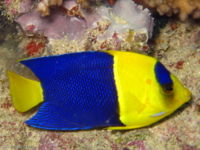Bicolor Angelfish (Centropyge bicolor)
From The Aquarium Wiki
Bicolor Angelfish
Centropyge bicolor
208 Litres (55 US G.)
13-15 cm (5.1-5.9")
8.1 - 8.4
22.2-25.6°C (72 -78 °F)
8-12 °d
1:1 M:F
8-13 years
Family
Pomacanthidae
Contents
Additional names
- Bicolor Angelfish, Bicolor Angel, Oriole Angel
Additional scientific names
- Chaetodon bicolor
Origin[edit]
- Indo-Pacific: East Africa to the Samoan and Phoenix Islands, north to southern Japan, south to New Caledonia; throughout Micronesia.
Sexing[edit]
- It is not possible to visually sex these Angelfish. As they mature they become female, if there are no males present, some will turn into males. It is very difficult, if impossible, to breed these Angelfish in captivity as fry are planktonic.
Tank compatibility[edit]
- These Angels will be territorial towards others of their own kind as well as other species of Angelfish. They are reef safe with caution as they can nip at soft corals and clams.
Diet[edit]
- This fish is primarily omnivorous, in the wild they will eat algae, crustaceans, corals and clams. Feed them plenty of high quality meaty foods such as mysid shrimp as well as spirulina and marine algaes.
Feeding regime[edit]
- Feed them once or twice a day. An underfed Angel may turn on corals and clams.
Environment specifics[edit]
- Needs an SG of 1.020 - 1.025. Requires plenty of tank space with places to hide and swim. Live rock is essential for this fish to graze on.
Behaviour[edit]
- May act semi-aggressively toward other fish, especially other Angels, as well as some coral.
Identification[edit]
- Typical angular Angelfish shape, yellow caudal with the majority of the mid-section to the caudal fin a vivid bright blue, the front section and head is also yellow with a blue band running from the top of the head to the eye.
Pictures[edit]
Videos[edit]
External links[edit]
- Fishbase (Mirrors:
 )
)
